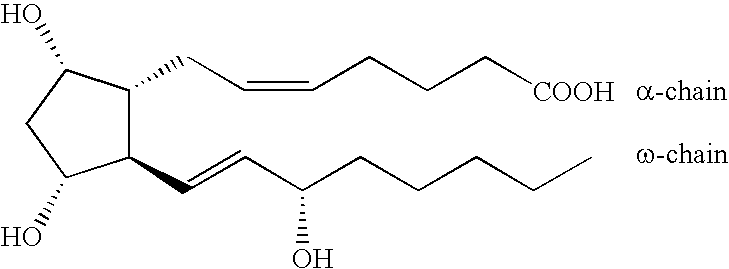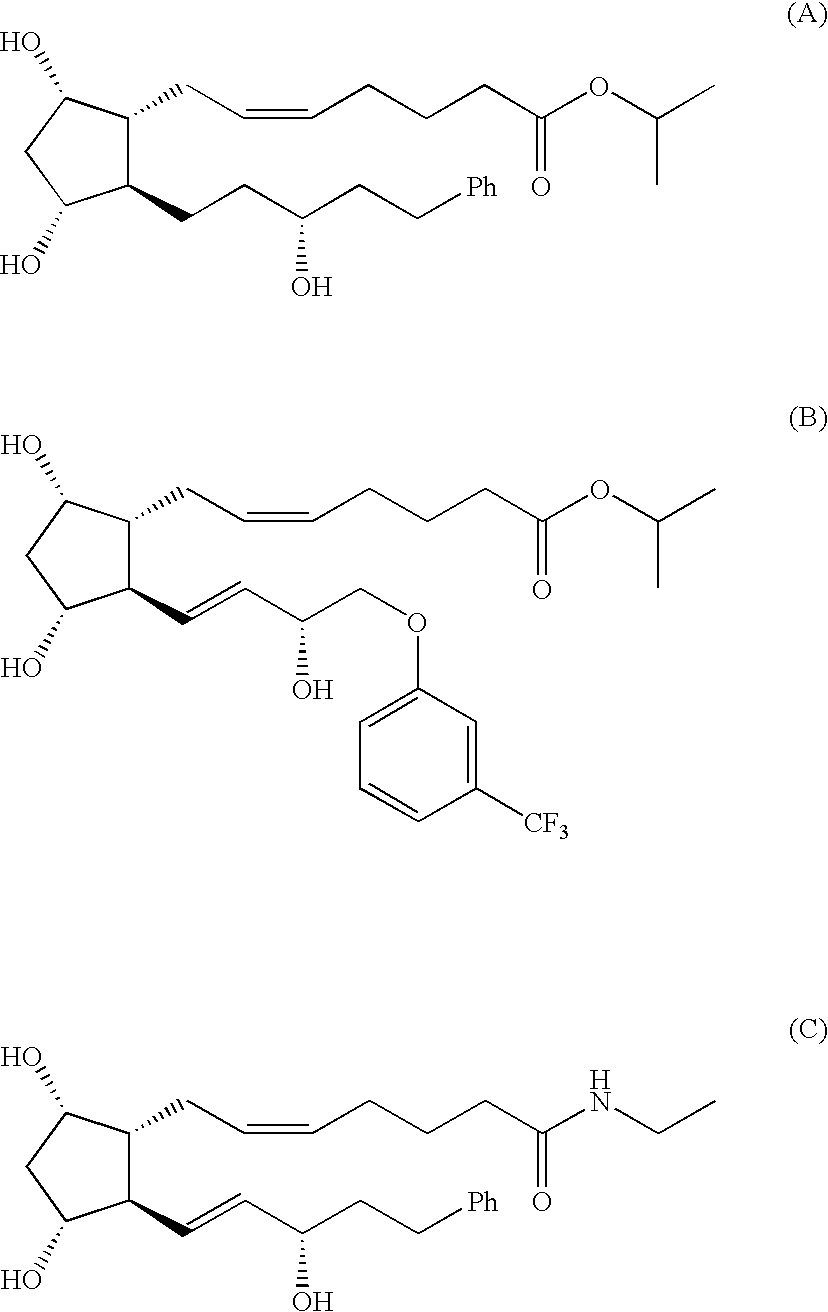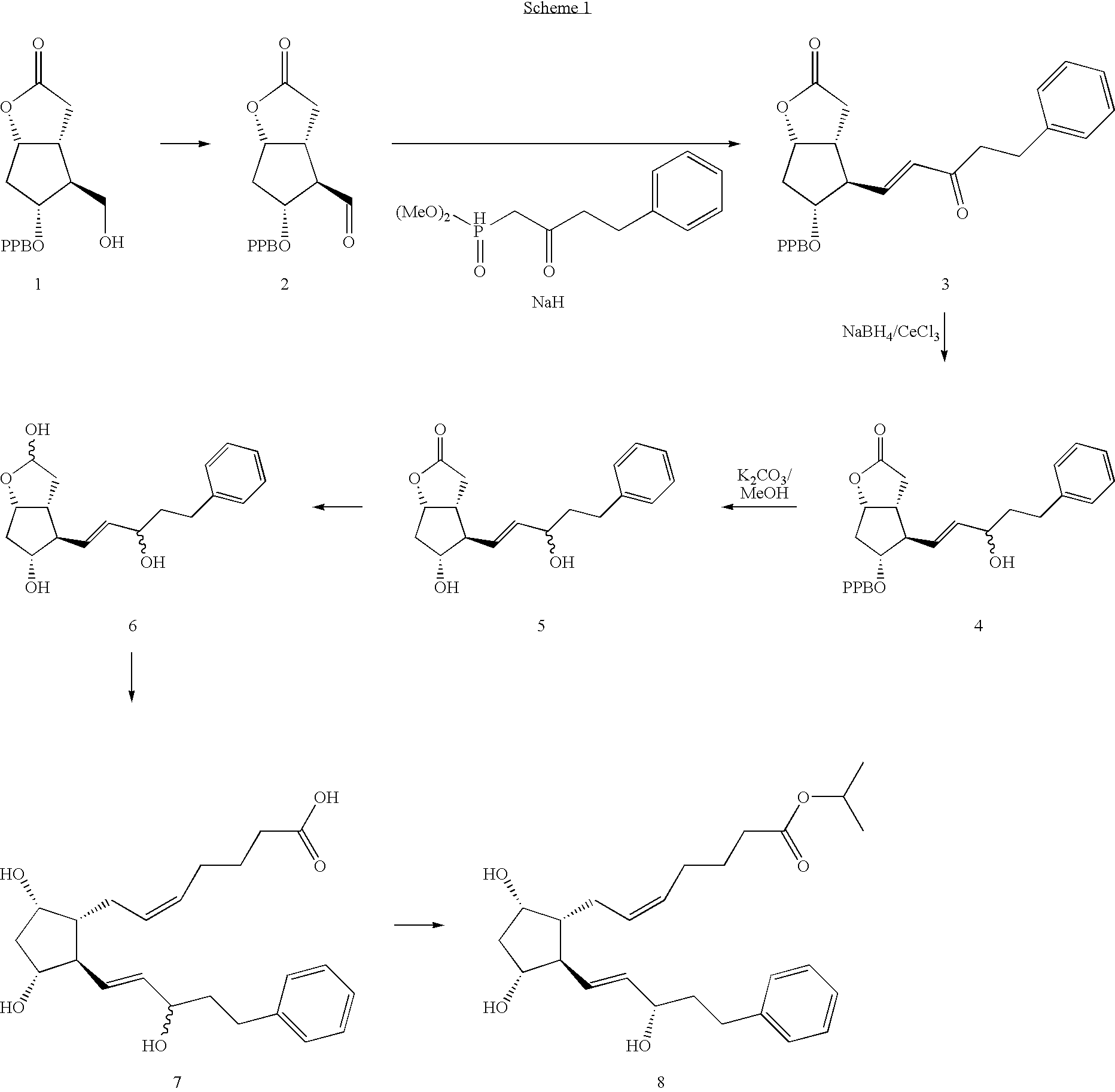Process for the Production of Prostaglandins and Prostaglandin Analogs
a technology of prostaglandins and analogs, applied in the field of process for the production of prostaglandins and prostaglandin analogs, can solve the problems of less efficiency, laborious process, and reduced 13-14-double bonding using catalytic hydrogenation, and achieve the effect of desired purity
- Summary
- Abstract
- Description
- Claims
- Application Information
AI Technical Summary
Benefits of technology
Problems solved by technology
Method used
Image
Examples
example 1
(2-oxo-4-phenyl-butyl)-phosphonic acid dimethyl ester (19a; R3=Me, W=—CH2CH2Ph)
[0317]To a solution of 68 g of methyl-phosphonic-acid dimethyl ester (MW=124.8; 1.6 eq.) in 325 mL of THF was added 218 mL of n-hexyllithium (2.5M in hexane; 1.6 eq.) at −80° C. The mixture was stirred for 30 min and a solution of 60 g of ethyl-3-phenyl propionate (MW=178.23, d=1.01, 1.0 eq.) in 90 mL of THF was added. The mixture was allowed to warm to ambient temperature and 150 mL of water were added. After separation of the layers the organic layer was extracted twice with water. The pH value of the combined aqueous layers was adjusted pH=2 with 5M HCl and then extracted twice with DCM. Removal of the organic solvents under reduced pressure gave 89 g of the title compound (Assay: 86.8%; Yield=89.7%). It is not necessary to dry to completion, a 50 w % solution in MED is also suitable for the next step.
[0318]1H-NMR (CDCl3, 300 MHz) δ(ppm)=2.95 (m, CH2, 4H), 3.10 (d, CH2, 2H, J 22.7 Hz), 3.75 (s, CH3, 3H...
example 2
Benzoic acid (3aR, 4R, 5R, 6aS)-2-oxo-4((E)-3-oxo-5-phenyl-pent-1-enyl)-hexahydro-cyclopenta[b]furan-5yl ester (20a, R2=Bz, W=—CH2CH2Ph)
[0320]To a solution of 14 mL of oxalyl chloride (COCl)2 (MW=126.9; 1.50 eq.) in 300 mL of DCM was added a mixture of 29 mL of DMSO (MW=78.1; 3.75 eq.) and 60 mL of DCM at −25° C. The resulting mixture was stirred for 15 min and then a solution of 30 g of benzoyl protected Corey alcohol (17a, R2=Bz; MW=276.29; 1.0 eq.) in 110 mL of DCM was added slowly. Then 84 mL of Hünig's base (MW=129.25; d=0.755; 4.5 eq.) were added and the resulting mixture was stirred for 30 min. Then the reaction mixture is poured onto a stirred, pre-cooled (0° C.) solution of 625 mL of water and 20 mL of glacial acetic acid (MW=60.05, d=1.05; 3.2 eq.) and stirred for another 10 min at 0° C. After separation of the layers the organic layer was washed once with an aqueous NaHCO3 solution (8.6%) and dried by addition of 6.8 mL of N,O-bis-trimethylsilylacetamide (MW=203.43, d=0.8...
example 3
Benzoic acid (3aR,4R,5R,6aS)-4-((E)-(S)-3-hydroxy-5-phenyl-pent-1-enyl)-2-oxo-hexahydro-cyclopenta[b]furan-5-yl ester (21a; R2=Bz, W=—CH2CH2Ph)
[0324]To a solution of 50 g of compound 20a (MW=406.8; 1.0 eq.; prepared as described in example 2) in 500 mL of dry THF was slowly added 190 mL of (−)-DIP-Cl solution (MW=320.76; 2.75 eq. 63% in heptane) at −30° C. After stirring for 6 h 180 mL of methanol were added and the mixture was warmed to room temperature. After removal of the solvent under reduced pressure the residue was solved in methanol / water (10 / 1) and extracted twice with heptane. After concentration of the aqueous layer ethyl acetate was added and the resulting mixture was consecutively extracted with an aqueous NaCl solution (9%) and with an aqueous NaHCO3 solution (8.6%). The organic solvents were removed under reduced pressure and the residue was recrystallized from ethyl acetate / n-heptane (1 / 7) to give 41 g of the title compound after drying (40° C., 10 mbar; yield=81.2%,...
PUM
| Property | Measurement | Unit |
|---|---|---|
| temperatures | aaaaa | aaaaa |
| temperatures | aaaaa | aaaaa |
| temperatures | aaaaa | aaaaa |
Abstract
Description
Claims
Application Information
 Login to View More
Login to View More - R&D
- Intellectual Property
- Life Sciences
- Materials
- Tech Scout
- Unparalleled Data Quality
- Higher Quality Content
- 60% Fewer Hallucinations
Browse by: Latest US Patents, China's latest patents, Technical Efficacy Thesaurus, Application Domain, Technology Topic, Popular Technical Reports.
© 2025 PatSnap. All rights reserved.Legal|Privacy policy|Modern Slavery Act Transparency Statement|Sitemap|About US| Contact US: help@patsnap.com



